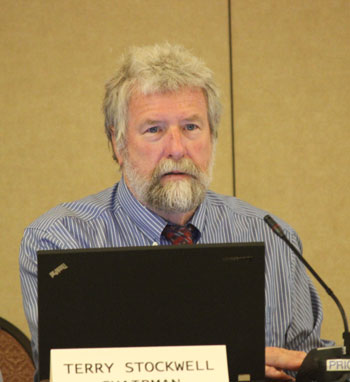Ropeless Lobster Fishing Under Consideration,
Near-term Use Unlikely
Continued from Homepage

Terry Stockwell, Maine’s representative on the NEFMC. “The Canadian government has made recent progress in implementing some large whale protection measures. But more work could be done with gear modification and gear marking. I think it will be a heavy lift to get the U.S. fishery to do more.” Fishermen’s Voice photo
Terry Alexander, NEFMC’s representative on the Atlantic Large Whale Take Reduction Team, submitted a report on a ropeless fishing workshop he attended Feb. 1, hosted by the Woods Hole Oceanographic Institution and New England Aquarium to discuss the feasibility of ropeless fixed gear fishing.
According to the report, “There is some new technology in ropeless fishing. One in particular is used in the Rock Lobster fishery in New Zealand called the ‘on call submerged headgear system.’ Many workshop participants raised concerns on the scalability of this technology. There are only 300 traps in the New Zealand fishery, and we have 3,000,000 lobster traps alone in New England. The units cost between $750 and $1500 each depending on the depths you are working and have annual repairs of between $75 and $150 depending on which units you have. Very expensive to buy and maintain at the volume that would be required for the lobster fishery in this region. Using these unit costs, a back of the envelope calculation would put the cost at $240,000 per lobster boat, which doesn’t include having the boat hauled out to install the transponders and computer gear on the boat to talk to the fusible link.”
Alexander wrote that, for the system, the rope is packed into a wire cage, similar to lobster trap wire. The cage is held to the bottom with an anchor attached.
“A fusible link is attached to the cage, and once the link is activated, the buoy on the rope floats up and you haul gear as normal,” he wrote.
Another ropeless fishing technology presented at the workshop had an airbag set-up with the same technology on the boat.
It’s likely that the
viability and concentration
of right whale prey, copepods,
are the driver of where
they’re going.
–Mike Asaro, NOAA
“For this set-up, there is an airbag attached to the first trap that is activated from the surface,” he wrote. “A small scuba tank is attached to the trap, as well as an inflatable plastic bag, that floats the trap to the surface. There was a lot of reservation from the industry about attaching anything to the trap that could affect the way it fishes. As a fisherman I can see that. The folks that build these things build them to the owner’s specs and that’s what works for them. Any time you mess with somebody’s gear that they have worked on for decades to perfect, you had better be able to show them it won’t affect the gear’s efficiency.”
Another system, he wrote, was a spool type sunken buoy.
“The end line to the trap would be anchored to the bottom and with a release mechanism that would release it,” he wrote. “Similar to the submerged headgear system, the buoy would float up and you would haul the gear as normal. The problem I can see with this is the buoys are big and they cannot be reloaded on the boat. So for every string of traps you haul you would need 2 end lines preloaded on the boat. Loading would be done on shore by a private company. If I’m a lobsterman I would change my profession to reloading these spools. That’s where the money would be. Many workshop participants also raised safety concerns relative to this technology.”
Yet another technology, he wrote, is a grappling system, consisting of a transponder on each end trap of a trawl.
“The boat would come up to a string of gear and see where it is on their plotter and grapple for it,” he wrote. “All the boats could see there was a string of gear there, but the only one that knows who owns the gear is you if you own it. Other than that they only see a string of gear. The problem I see here is that the prototype transponder was $18,000 to build. As they gear up to build these things they get down to $281 if you mass produce 1 million of them. I’m not confident that number is achievable.”
Alexander wrote that a factor causing more whale entanglements might be changes in rope type.
“They have invented steel line that is much stronger than the ropes they used in the 90s,” he wrote. “They cause more injuries and deaths from entanglements.”
The state of Maine is working on testing breaking strengths and a new system of weak links in rope to mitigate the problem.
A rule (FPIP) requiring
nations exporting fish
and fish products to
the U.S. to be held to
the same standards
as U.S. commercial
fishing operations.
More information about the various systems, wrote Alexander, can be found at the following websites:
In a presentation to NEFMC, Mike Asaro, an entanglement prevention policy expert with the National Oceanic and Atmospheric Administration (NOAA), said the direct applications of the ropeless technologies to the fisheries is unclear.
Asaro said the use of sinking groundline in Maine’s lobster fishery, since 2009, has been effective.
“Prior to 2009 we used to recover groundline as part of entanglements, and we haven’t anymore,” said Asaro. “So we know that regulation is highly effective.”
It’s difficult to determine factors that might be increasing the incidence of entanglements, Asaro said. “After many decades of modestly increasing population size, there’s a dramatic drop-off, which would suggest some dramatic event,” said Asaro. “But from what we know of the regulation of the fisheries, that isn’t the case.”
Since 2010, there has been a significant change in right whale distribution along with population decline, said Asaro.
“We’re not seeing them in areas where we used to see them,” he said. For example, a year ago, over 200 right whales were sighted in Cape Cod Bay. The highest number sighted in more recent surveys was 50, and sometimes 30 or fewer.
Population shifts may be due to shifts in prey, he said.

Mike Asaro, entanglement prevention policy expert with NOAA. Asaro said the use of sinking groundline in Maine’s lobster fishery, since 2009, has been effective. “Prior to 2009 we used to recover groundline as part of entanglements, and we haven’t anymore. So we know that regulation is highly effective.” NOAA photo
“Foraging behavior dictates when and where they aggregate,” Asaro said. “It’s likely that the viability and concentration of right whale prey, copepods, are the driver of where they’re going.”
The Canadian government has made recent progress in implementing some large whale protection measures, said Terry Stockwell, Maine’s representative on the NEFMC. But more work could be done with gear modification and gear marking, he said. “I think it will be a heavy lift to get the U.S. fishery to do more,” Stockwell added.
Asaro noted that NOAA in 2016 implemented the “Fish and Fish Product Import Provisions of the Marine Mammal Protection Act,” a rule that aims to reduce marine mammal bycatch associated with international commercial fishing operations, by requiring nations exporting fish and fish products to the U.S. to be held to the same standards as U.S. commercial fishing operations. The Canadian snow crab and lobster fisheries are on that list of fisheries, he said.
“They’re being reactive, whereas the U.S. fisheries have been proactive,” said Department of Marine Resources Commissioners Patrick Keliher said of Canadian management of their fisheries in relation to right whales. “That’s a big distinction that we can’t lose sight of.”
“This issue of a level playing field between the U.S. and Canada is going to be a difficult one,” said NEFMC member Michael Sissenwine. “It’s clear the U.S. has to do everything it can. It’s the law. But we need a response from Canada that’s comparable.”
Sissenwine asked if there is a calculation of a number that would be considered sustainable for the right whale population, and of the extent to which each factor contributes to the problem.
“Regarding optimal population size, I don’t know,” responded Asaro. “There is some evidence…that says the population could have been 10,000 animals at some point. It could have been more. But we don’t know.” Regarding factors limiting recovery, the low calving rate is considered the driver of the problem, he said. “It’s the most important thing right now,” he said. “You can see modest [population] growth during times when there was still entanglement and ship strike mortality, so human impacts were still as high as they are now and maybe even higher, but there was still growth. But the biggest change since 2010, that we can probably pin the decline on, is that the population is no longer replacing the animals that have been killed. That could be a number of threats: It could be related to illness, ship strike, entanglements. It’s probably all three.”
One NEFMC member said gear marking, especially in offshore waters, is overly broad and fails to collect information on localized interactions between whales and gear.
Asaro said there’s discussion about implementing more diverse colors and expanding the frequency of the marks. “It’s an important topic and getting more localized information on recovered gear is a priority,” he said.

“This issue of a level playing field between the U.S. and Canada is going to be a difficult one,” said NEFMC member Michael Sissenwine. “It’s clear the U.S. has to do everything it can. It’s the law. But we need a response from Canada that’s comparable.” Fishermen’s Voice photo
Meghan Lapp of Seafreeze Ltd. said it’s also important to look at low-frequency noise generated by offshore wind farms as a potential cause of right whale mortality.
According to Asaro’s presentation to NEFMC, a five-year right whale status review issued in 2017 confirmed the whale’s endangered status is due to:
• A low rate of reproduction,
• Longer calving intervals,
• Declining population abundance,
• Continued mortality from vessel and fishing gear interactions,
• Changes in prey availability, and
• Increased transboundary movement and risk.
The ALWTRT’s planned activities for this fall include a meeting to consider measures that might be necessary to reduce the effects of gear entanglements on right whales. The team’s two subgroups will continue investigating the feasibility of ropeless fishing, whale release rope, and gear marking.
According to a report from the Ropeless Fishing Subgroup, further investigation of ropeless technology was supported, and it was determined that must involve fishing industry in research and development. Under consideration is allowing ropeless fishing in closed areas. But ropeless technology is not considered a near-term solution.
According to a report from the Whale Release Rope/Gear Marking Subgroup, some themes emerged during discussions. They included:
• Shifting distribution of whales makes it difficult to evaluate effectiveness of current measures or to design new measures.
• Lack of data on existing fixed gear confounds attempt to interpret significance of relationship between reduced serious injury and low breaking strength gear.
